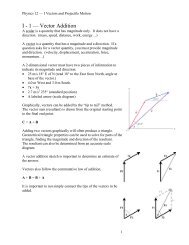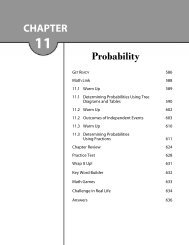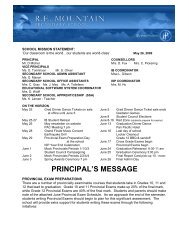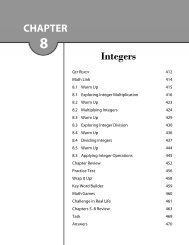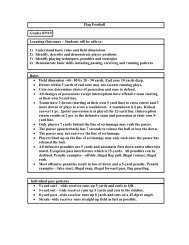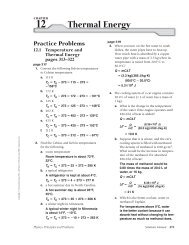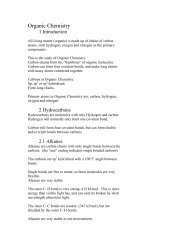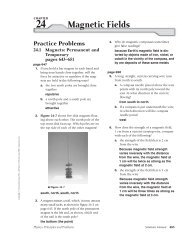Physics Solutions Manual
Physics Solutions Manual
Physics Solutions Manual
Create successful ePaper yourself
Turn your PDF publications into a flip-book with our unique Google optimized e-Paper software.
Chapter 4 continued<br />
55. When you look at the label of the product<br />
in Figure 4-19 to get an idea of how much<br />
the box contains, does it tell you its mass,<br />
weight, or both? Would you need to make<br />
any changes to this label to make it correct<br />
for consumption on the Moon?<br />
■ Figure 4-19<br />
The ounces tell you the weight in English<br />
units. The grams tell you the mass in<br />
metric units. The label would need to<br />
read “2 oz” to be correct on the Moon.<br />
The grams would remain unchanged.<br />
56. From the top of a tall building, you drop<br />
two table-tennis balls, one filled with air<br />
and the other with water. Both experience<br />
air resistance as they fall. Which ball reaches<br />
terminal velocity first? Do both hit the<br />
ground at the same time?<br />
The lighter, air-filled table tennis ball<br />
reaches terminal velocity first. Its mass<br />
is less for the same shape and size, so<br />
the friction force of upward air resistance<br />
becomes equal to the downward<br />
force of mg sooner. Because the force<br />
of gravity on the water-filled table-tennis<br />
ball (more mass) is larger, its terminal<br />
velocity is larger, and it strikes the<br />
ground first.<br />
57. It can be said that 1 kg equals 2.2 lb. What<br />
does this statement mean? What would be<br />
the proper way of making the comparison?<br />
It means that on Earth’s surface, the<br />
weight of 1 kg is equivalent to 2.2 lb.<br />
You should compare masses to masses<br />
and weights to weights. Thus 9.8 N<br />
equals 2.2 lb.<br />
58. You toss a ball straight up into the air.<br />
a. Draw a free-body diagram for the ball at<br />
three points during its motion: on the<br />
way up, at the very top, and on the way<br />
down. Specifically identify the forces<br />
acting on the ball and their agents.<br />
b. What is the velocity of the ball at the<br />
very top of the motion?<br />
0 m/s<br />
c. What is the acceleration of the ball at<br />
this same point?<br />
Because the only force acting on it<br />
is the gravitational attraction of<br />
Earth, a 9.80 m/s 2 .<br />
Mastering Problems<br />
4.1 Force and Motion<br />
page 113<br />
Level 1<br />
59. What is the net force acting on a 1.0-kg ball<br />
in free-fall?<br />
F net F g mg<br />
(1.0 kg)(9.80 m/s 2 )<br />
9.8 N<br />
On the way up<br />
At the top<br />
On the way down<br />
F Earth’s mass on ball<br />
F Earth’s mass on ball<br />
F Earth’s mass on ball<br />
72 <strong>Solutions</strong> <strong>Manual</strong> <strong>Physics</strong>: Principles and Problems<br />
Copyright © Glencoe/McGraw-Hill, a division of The McGraw-Hill Companies, Inc.









